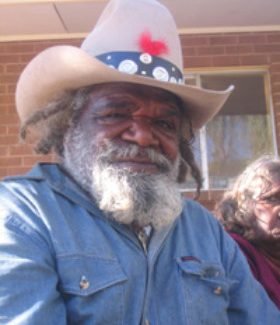RONNIE TJAMPITJINPA
MARKET ANALYSIS

Ronnie Tjampitjinpa began to paint early in life and outlived most of his older contemporaries. He has enjoyed a long and fruitful career as a painter during which he has produced works in a variety of different styles. Apart from a small number of early boards from the early 1970s and generic Tingari paintings typical of the late 1970s and early 1980s, his distinctive trademark is bold geometric design. At their best, these works produced in the second half of his career, have a strength and power that commands attention while his lesser works seem stilted and repetitious by comparison. Although he painted before Bardon left Papunya, his best results have been for works created during the 1990s. This is quite the reverse of the other ‘Bardon’ artists. His early works are rare and do not share the visual strength of the early boards by many of the older men. While Ronnie has painted only occasionally for Papunya Tula since the mid to late 1990s it has been works with this provenance that have dominated his highest secondary market results. His top twenty sales have been for predominantly large works painted for private dealers, and it is expected that major pieces like these will continue to increase in value while his many minor works will languish. Ronnie’s offerings at auction have been voluminous with around 500 works offered for sale since they first appeared in 1995. His low clearance rate is due principally to his independence as an artist in a market where provenance was considered so important.
Of his top ten results at the end of 2006 only one had come from a source other than Papunya Tula, however, by the end of 2009 results for non-art centre provenanced works had increased to four. The word results is underlined here as 4 of these results have been set for one single painting. The following scenario is a supposition on my part. I have no proof whatsoever of its veracity, but Kumpuralgna 1996 has appeared in four Menzies sales over a period of 9 years. This 364 x 153 cm work was commissioned by Kimberley Art in Melbourne from dealer Peter Van Groessen and featured a number of the artist’s most important themes. It was purchased first in November 2006 for $54,000 (Lot 109) by a Rod Menzies buyers' consortium of which Menzies most probably retained 50% of the ownership. When resold in March 2008, it was reputed to have sold for just $60,000. Now Menzies probably owned 25%! It appeared once more in 2010 and was recorded as having sold for $66,000, and Menzies had most likely now divested himself of the work. Finally five years later, in 2015, it recorded the artist's second highest record price when it sold for $79,773 netting the syndicate Menzies cobbled together a modest profit on their 'investment'.
In 2013 one of Ronnie’s early boards, Ceremonial Dreaming 1972, displaced another 1972 board as his highest record for an early work which had stood since 1996. In what has been a rare occurrence, a not-dissimilar work almost twice the size was offered for sale by Lawson~Menzies in May 2007. Carrying an ambitious presale estimate of $75,000-95,000 Ceremonial Dreaming 1972 had failed to find a buyer until a week after the auction when reportedly sold by private treaty for $50,000.
In 2017 his previous record was shattered when Wilkinkarra (Lake Mackey) fetched almost double the record of $79,812 it had replaced. Sotheby's had last sold the work in 2000 for $63,000 which was the record at the time. In 2017, after having enjoyed the work for over 15 years, the collector released the work to auction, making an extremely healthy profit. Then, in 2019, Ronnie's record was once again obliterated when Tingari Ceremonies at the Site of Pintjun 1989 sold for a whopping A$353,169 including BP at Sotheby's New York Aboriginal art auction. This result more than doubled 2017’s record-setting price of A$151,280. Like most of his highest prices, this work was created at Papunya Tula for a major dealer in Gabrielle Pizzi.
Ronnie Tjampitjinpa was and still is a highly successful artist in the primary market. His output was prodigious until 2012-2013 when his health began to deteriorate and began struggling to paint with small brushes. Until the last few years, his highest results hovered around $50,000 with a steady decline in value after the $25,000 mark. In recent years, we have seen his record doubled on a near-regular basis. These results continue to follow the familiar provenance and style model, even if the value has increased fivefold since 2002 (after which his top values plateaued for over a decade.) Evidence suggests that while his works are still available in the primary market, all but the very best will languish at auction. Ronnie, however, is a most important figure in the history of Western Desert painting. His works will continue to demand record prices well into the foreseeable future.
© Adrian Newstead

